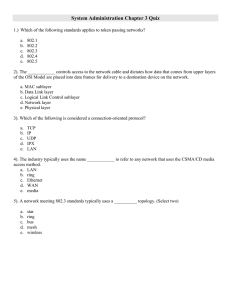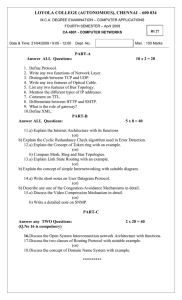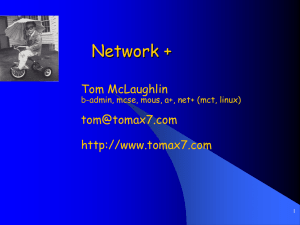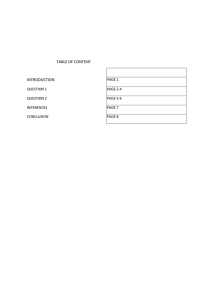Mid Term Review
advertisement
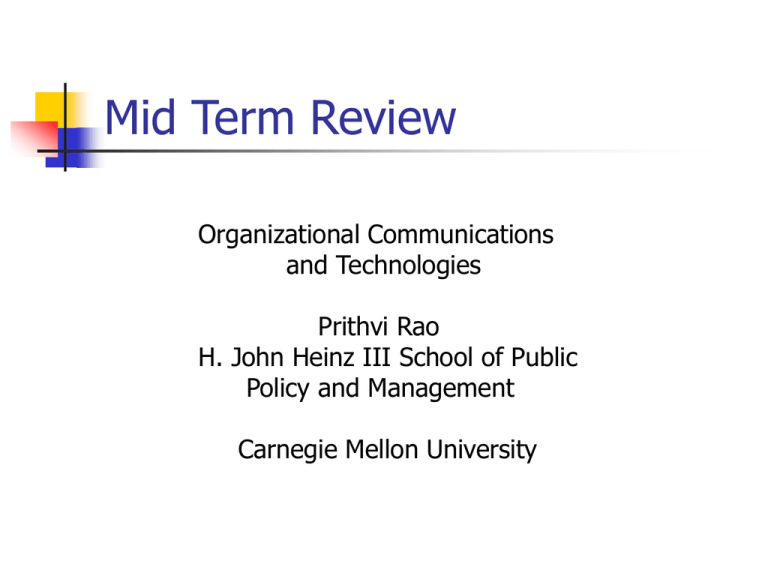
Mid Term Review Organizational Communications and Technologies Prithvi Rao H. John Heinz III School of Public Policy and Management Carnegie Mellon University Objectives Present a guideline for study for the mid term exam Review topics from the class lectures up to Oct 5th 1999 Identify readings that are relevant. All readings that have been assigned in the lecture notes are included as sources for exam questions. Readings William Stallings and Richard Van Slyke Business Data Communications Third Edition Chapters: 4, 5, 6, 7, 8, 9, 12 Papers cited in the class web-site will not be a source for questions but reading them will help in answering some questions Possible Question Format Essay type will expect you to provide explanations beyond citing information in the notes. These questions are intended to evaluate your thinking based on information in the notes and readings. These will be less than a single page in length Multiple choice will provide you with various choices where one or more answers are correct and you will be asked to select one of several choices. PLEASE MAKE YOUR WRITING LEGIBLE Evolution of PC-Lans Driving force behind the evolution of the PC Lan Centralized vs the decentralized paradigm Advantages and disadvantage Organizational structures evolving from? Centralized steep functional communications supported by? PC networks are ? Communication systems (will have choices to replace the question mark…part of a question) Enterprise networks are ? Issues that network managers must cope with in the future First stand-alone mainframe could connect to mainframes? Network Classification and Standards Various classification issues Connection oriented vs non-connection oriented OSI model and its layers How many layers What do they do Name other protocol models Why do they exist Open systems vs proprietary systems Goals of the open systems movement Have they been successful Network Data Error Handling and related issues Various kinds of sampling Requirements of synchronous communication Manchester encoding schemes How to recover from errors Bandwidth of media Network Design and Token Ring Cabling Issues in decentralization Issues in performance of network Client / Server definition Cabling issues Issues in Network Interface Card (NIC) Various kinds of media When do you use which media Network Components and Equipment Components of a network Various kinds of servers Functionality of client workstations Hubs Backbones Network Layouts and Topology Various topologies presented Definition of network topology Fault isolation on linear bus topology Trouble shooting Token ring configuration issues Media Access Protocols Familiarization with media access protocols Token ring definition and features Kinds of stations in token ring and their purpose Types of broadcast media access Difference in the Ethernet 2 and 802.3 framing Service Access Points definition and purpose DSAP ? Network Operating Systems What are NOS and why are they required? What do they facilitate in a networked environment What do client / server operating systems include Describe various layers of the OSI model IP operates at which level? Discuss difference between client/server and peer-to-peer Which is more efficient? Internetworking Networks Issues in internetworking Repeaters definition and functionality Layer at which repeater works Bridges definition and functionality Layer at which bridge works Routers definition and functionality Layer at which routers work Comparison in of above Performance Functionality Domain Name System DNS issues in internetworking Definition and historical perspective How are IP addresses assigned What are some future issues with IP address assignment Resource type in DNS; what are they for? Operational steps Network Debugging Tools Use of network debugging tools List common tools What do they do (not detailed explanation)

